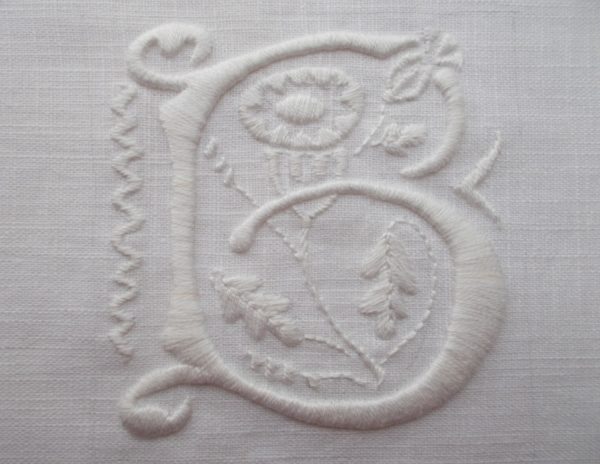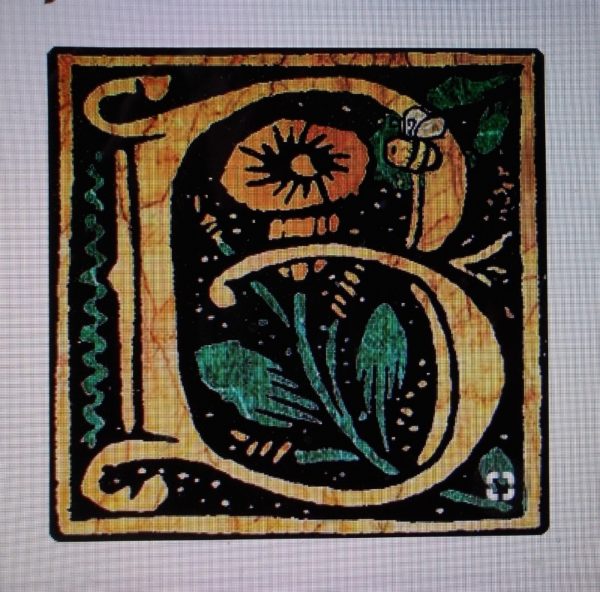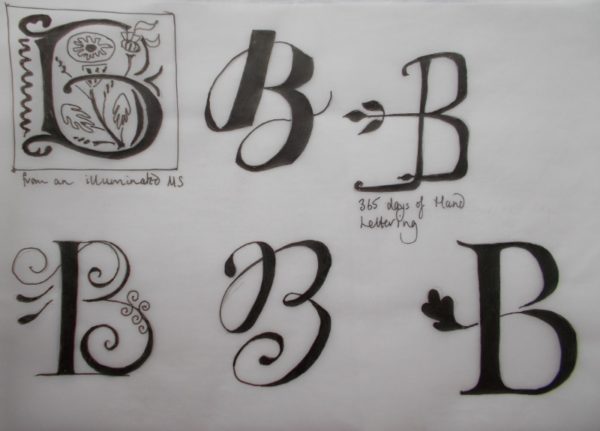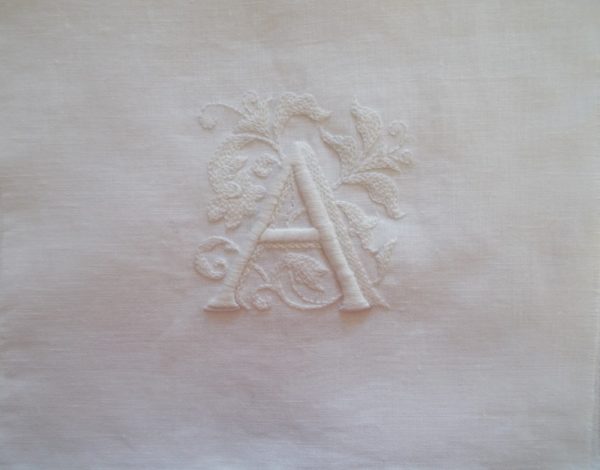
A whitework alphabet: letter A (hand embroidered by Mary Addison)
A pre-Easter week of visiting family coincided with the best sort of weather for getting out and about. With David’s son and four year old granddaughter (sadly mum had to work) we went by car deeper into real Kent to Penshurst Place via country lanes laced with blossom and young greenery and through pretty little towns and villages lined with buildings just right for their setting. I say just right for their setting as the geology of the British Isles and South East England in particular is very complicated and varies greatly over even short distances. The underlying structure of Kent is like half an ice cream bomb whose curved top has been sliced off and the inner layers have been mined by spoons seeking hidden deliciousness. Weak rocks revealed in this way have been eroded over time while their more resistant neighbours are visible as ridges. Traditionally people used local materials for building stone, and on even a short journey like ours you can play a game guessing at the underlying geology by noting the buildings you pass – sudden pockets of knapped flint houses (on chalk) and brick and tile hung facades (clay) contrast with half timbered, stone based buildings, though stone is so varied round here you’d need a reference book to hand to nail exactly which stone.
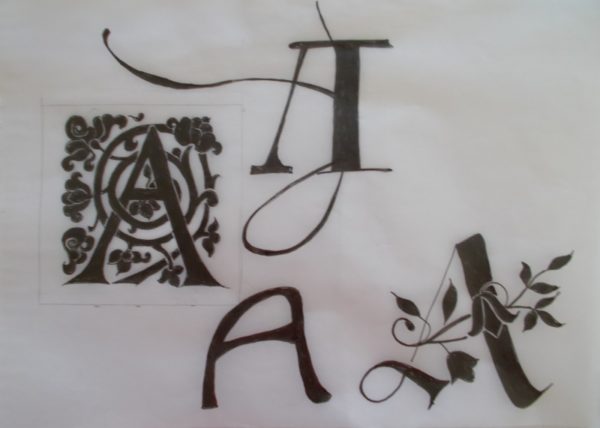
Sketches of various As found online
Discerning local geology being too taxing for a 4 year old, we focused on wild flowers instead, aided by The i-Spy Book of Wild Flowers found in Penshurst Place’s shop. I used to ruin masses of these small hand-sized books when I was little – scrawling all over them, scrumpling them up into a pocket or bike basket and then, disappointed, finding lemonade or chocolate had leaked all over them and stuck the pages together. I thought that, along with Ladybird Books (proper ones, not the horrible new sort, with titles like The Midlife Crisis, The Hangover or Brexit) they had disappeared, and I now find they had (for 7 years) until Michelin, appreciating their charm and potential for making money, relaunched them in 2009. (I resisted buying half a dozen different titles.) Armed with grandad’s pen we meandered round the gardens, occasionally calling the little one to heel so that she could view, admire, name and tick off some of the commonest of our wildflowers. I think we managed 7 0r 8 ticks which was good going considering the gardens were seriously cared for and very few flowers of any sort, wild or cultivated, were out anyway. Strangely, there was no entry for forget-me-nots, which we did see in plenty! There are, however, few better ways to tire a young child out than having them run up to every yellow flower just to check if it’s the celandine grandad feels sure he saw somewhere. (No celandines – land not wet enough, I suspect.)
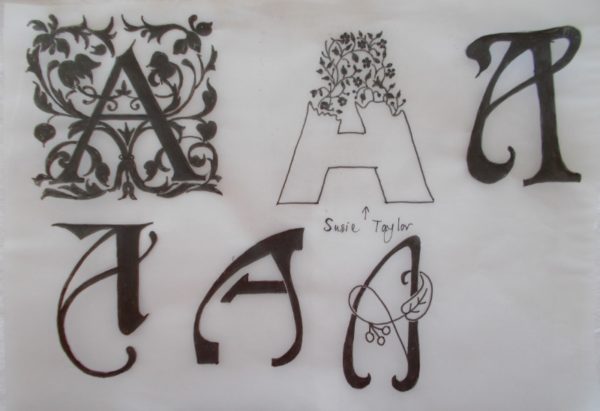
Sketches of various As found online
David and I nipped into the house while others went to the adventure playground. The Great Hall still had a huge central open hearth and piles of ashes suggested fire had recently burned here. I was much taken with a small room completely lined with plate racks and narrow shelves and thought how nice it would be to sit at embroidery or knitting in somewhere like that. With windows out on to the garden you could look up from your needle and admire nature or glance round the room and enjoy focusing on your favourite plates or tiny teapots which dated from a time tea was so expensive that you drank it out of egg cups. In other rooms, kindly stewards told the stories depicted in the tapestry hangings and, when asked, checked up on what dye had been used for the yellow which had faded badly. (Onion skins or saffron; the madder red was still luminously rosy and gorgeous.) BBC’s recent adaptation of Hilary Mantel’s Wolf Hall used many rooms in the film, most notably the end of the Long Gallery where you might remember seeing Anne Boleyn embroidering surrounded by her ladies in waiting and musicians. Three costumes used in the filming were on display somewhat unimaginatively, though at least you could get quite close to them and see how the brocade of a skirt was stencilled on and how on a man’s shirt, little puffs of fabric were trapped between seams to suggest a billowy undershirt pulled through slashes in an overgarment. Overall it was very historical and grand but not somewhere I would have liked to live in (with the exception of the crockery cupboard).
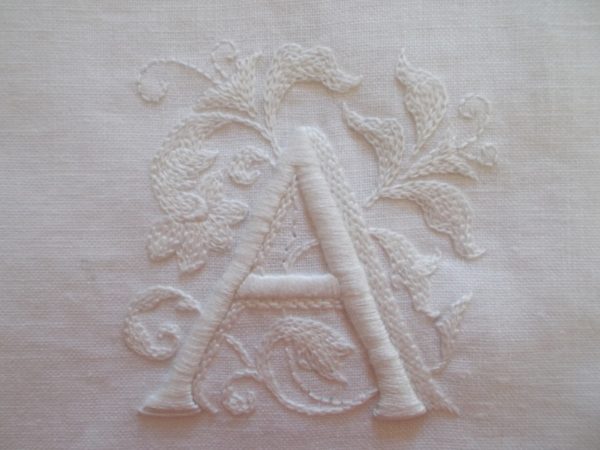
A whitework alphabet: letter A (hand embroidered by Mary Addison)
As it’s not worth having a grandad who’s also an art historian unless he educates you just a little about art, we also went to Dulwich Picture Gallery. Ticking off a few more flowers in our iSpy book en route, and having enjoyed a light lunch outdoors in the museum cafe, we made direct for the museum shop and chose our 2 postcards. (See this post for why.) Great ideas often fail tripped up by unconsidered practicalities. There were not many postcards. Of the two paintings chosen, one was in store (one of the stewards said he had never seen it on display – but he was quite young) and the other picture was a bit too high up to be clearly viewed. Undeterred we bought another postcard (of a painting we knew to be there!) and spent as long as we could avoiding its location while seemingly searching for it!! Once found there was the complicated matter of explaining why Armida had a dagger in her hand as she gazed on the sleeping body of Rinaldo. As Poussin’s painting, Rinaldo and Armida doesn’t show the moment Armida actually kills Rinaldo, we were able to focus on the restraining influence of the urgent Cupid tugging energetically on Armida’s dagger wielding arm. En route we did discover a tiny portrait of Queen Victoria as a four year old princess which we all liked – but of course, there was no postcard of it! In all we had been in the gallery for about 40 minutes. Dulwich Picture Gallery is a private gallery but children are free and David and I got in free as we subscribe to The National Art Collections Fund. Whether a forty minute visit is worth paying £18 for (two full priced adults) is another matter. (Most British art galleries are free.)
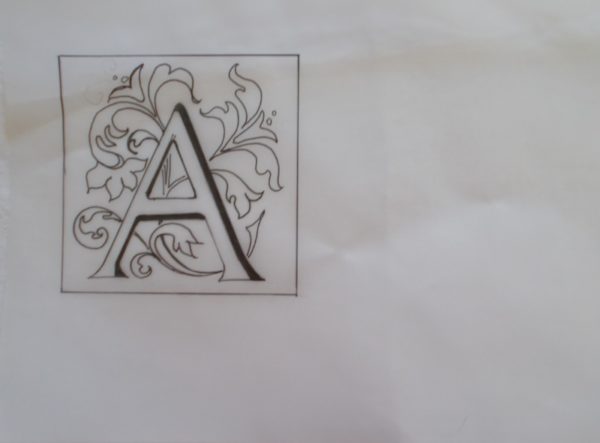
Sketch for whitework letter
Geology guided our lives yet once more as we took the train from Beckenham to Hastings via Orpington. The line cuts across the undulating terrain of the High Weald necessitating 8 tunnels, two of which are almost half a mile in length. The last tunnel but one is known as Bopeep Tunnel – nothing to do with the nursery rhyme but a reminder that Customs and Excisemen were never far away. As with lots of English seaside resorts the newer part of the town is a sad mess but the Old Town, with narrow winding roads, still has the feeling of somewhere like Rye, another of the Cinque ports. The Jerwood Gallery (soon to be renamed we learned) was small but beautifully designed and had a suitably small but enjoyable art collection. From the café on the first floor, fishing boats and fishermen’ s huts suggested a time when the sea was more important to the town that just being a splendid backdrop. We never got up the cliffs to the more sedate Victorian/Edwardian part of the town but saw enough to be happy to go back again sometime. Foyle’s War always makes the town look wonderful.
Twice last week we crossed London from Paddington to Victoria stations and through the clever routing of our taxi drivers managed to avoid the disruption climate change protesters. We might otherwise have gone by bus.
Here begins my second embroidered alphabet, this one to be all in whitework and so a bit more ornate than the last.
